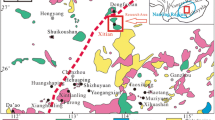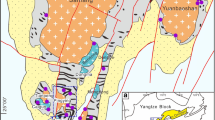Abstract
Vein-type tin mineralization in the Dadoushan deposit, Laochang ore field, Gejiu district, SW China, is predominantly hosted in Triassic carbonate rocks (Gejiu Formation) over cupolas of the unexposed Laochang equigranular granite intrusion. The most common vein mineral is tourmaline, accompanied by skarn minerals (garnet, diopside, epidote, phlogopite) and beryl. The main ore mineral is cassiterite, accompanied by minor chalcopyrite, pyrrhotite, and pyrite, as well as scheelite. The tin ore grade varies with depth, with the highest grades (~1.2 % Sn) prevalent in the lower part of the vein zone. Muscovite 40Ar–39Ar dating yielded a plateau age of 82.7 ± 0.7 Ma which defines the age of the vein-type mineralization. Measured sulfur isotope compositions (δ 34S = −4.1 to 3.9 ‰) of the sulfides (arsenopyrite, chalcopyrite, pyrite, and pyrrhotite) indicate that the sulfur in veins is mainly derived from a magmatic source. The sulfur isotope values of the ores are consistent with those from the underlying granite (Laochang equigranular granite, −3.7 to 0.1 ‰) but are different from the carbonate wall rocks of the Gejiu Formation (7.1 to 11.1 ‰). The calculated and measured oxygen and hydrogen isotope compositions of the ore-forming fluids (δ 18OH2O = −2.4 to 5.5 ‰, δD = −86 to −77 ‰) suggest an initially magmatic fluid which gradually evolved towards meteoric water during tin mineralization.









Similar content being viewed by others
References
308 Geological Party (1984) Geology of tin deposit in Gejiu area. Metallurgical Industry, Beijing, pp 50–90, in Chinese
Cheng YB, Mao JW (2010) Age and geochemistry of granites in Gejiu area, Yunnan Province, SW China: constraints on their petrogenesis and corresponding tectonic setting. Lithos 120:258–276
Cheng YB, Mao JW (2011) Petrogenesis and geodynamic setting of the Gejiu igneous complex from the western Cathaysia block, South China. Lithos, under review
Cheng YB, Mao JW, Rusk B (2011) Metal zonation in the world-class Gejiu Sn-Cu polymetallic deposit, SW China. 11th SGA Biennial Conference abstract, 94–96
Clayton RN, Mayeda TK (1963) The use of bromine pentafluoride in the extraction of oxygen from oxides and silicates for isotopic analysis. Geochim Cosmochim Acta 27:43–52
Dai FS (1996) Characteristics and evolution of rock series, lithogenesis, metallogenesis of crust-derived anatectin magma in Gejiu ore field. Yunnan Geology 15:330–344 (in Chinese with English abstract)
Dalrymple GB, Lamphere MA (1971) 40Ar/39Ar technique of K–Ar dating: a comparison with the conventional technique. Earth Planet Sci Lett 12:300–308
Guo CL, Mao JW, Bierlien F, Chen ZH, Chen YC, Li CB, Zeng ZL (2011) SHRIMP U–Pb (zircon), Ar–Ar (muscovite) and Re–Os (molybdenite) isotopic dating of the Taoxikeng tungsten deposit, South China Block. Ore Geol Rev 43:26–39
Hanson GN, Simmons KR, Bence AE (1975) 40Ar/39Ar spectrum ages for biotite, hornblende and muscovite in a contact metamorphic zone. Geochim Cosmochim Acta 39:1269–1278
Ludwig KR (2003) User's manual for Isoplot 3.00: a geochronological toolkit for Microsoft Excel, 4. Berkeley Geochronology Center, Berkeley
Mao JW, Wang YT, Li HM, Pirajno F, Zhang CQ, Wang RT (2008) The relationship of mantle-derived fluids to gold metallogenesis in the Jiaodong Peninsula: evidence from D–O–C–S isotope systematics. Ore Geol Rev 33:361–381
Ohmoto H (1986) Stable isotope geochemistry of ore deposits. Rev Mineral Geochem 16:491–559
Peng CD (1985) Discussion about the ore forming conditions, types and deposit model. Yunnan Geology 4:17–32 (in Chinese)
Qin DX, Li YS (2008) Studies on the geology of the Gejiu Sn–Cu deposit. Science, Beijing, pp 1–180
Robinson BW, Kusakabe M (1975) Quantitative preparation of sulphur dioxide for 34S/32S analyses from sulphides by combustion with cuprous oxide. Anal Chem 47:1179–1181
Sheppard SMF (1986) Characterization and isotopic variations in natural waters. Rev Mineral Geochem 16:165–183
Simon K (2001) Does δD from fluid inclusion in quartz reflect the original hydrothermal fluids? Chem Geol 177:483–495
Steiger RH, Jäger E (1977) Subcommission on geochronology: convention on the use of decay constants in geo and cosmochronology. Earth Planet Sci Lett 36:359–362
Wang SS (1983) Dating of the Chinese K–Ar standard sample (Fangshan biotite, ZBH-25) by using the 40Ar/39Ar method. Sci Geol Sin 4:315–321 (in Chinese with English abstract)
Wang Q, Li JW, Jian P, Zhao ZH, Xiong XL, Bao ZW, Xu JF, Li CF, Ma JL (2005) Alkaline syenites in eastern Cathaysia (south China): link to Permian–Triassic transtension. Earth and Planetary Science Letters 230: 339–354
Wu QS, Xu JZ, Yang Z (1984) Study on Sr isotope character and prospecting criteria of tin-bearing granite of Gejiu area. Geochemica 4:293–302 (in Chinese with English abstract)
Zhuang YQ, Wang RZ, Yang SP (1996) Tin-copper polymetallic deposits. Earthquake Publishing House, Beijing, pp 38–101, in Chinese
Acknowledgments
Prof. Franco Pirajno is thanked for valuable discussions during the field trip. Prof. Peter Laznicka is thanked for detailed language polishing and constructive scientific comments, which greatly improved the quality of this manuscript. Mr. Guopei Mo, Mr. Xiang Tong, Mr. Junde Wu, and many other geo-workers from the Yunnan Tin Group provided invaluable assistance during our field work, which is highly appreciated. Xiaolong Li and Juan Zhang from China University of Geosciences (Beijing) are thanked for their help with some laboratory work. This study was supported by the National Science Foundation of China (40930419), Special Research Funding for the Public Benefit Sponsored by MLR (200911007-12), Research Program of the Yunnan Tin Group (2010-04A), Geological Survey of China Project (1212011120994), and the Fundamental Research Fund for the Central Universities (2-9-2010-21).
Author information
Authors and Affiliations
Corresponding author
Additional information
Editorial handling: B. Lehmann
Electronic supplementary material
Below is the link to the electronic supplementary material.
Table 1
Muscovite 40Ar-39Ar analytical data of sample D037-2 from Dadoushan open pit, Gejiu district, SW China (XLS 16 kb)
Table 2
Sulfur isotope composition of the Dadoushan deposit (XLS 16 kb)
Table 3
H-O isotope composition of quartz from the Dadoushan vein tin deposit, Gejiu district, SW China (XLS 15 kb)
Rights and permissions
About this article
Cite this article
Cheng, Y., Mao, J. & Yang, Z. Geology and vein tin mineralization in the Dadoushan deposit, Gejiu district, SW China. Miner Deposita 47, 701–712 (2012). https://doi.org/10.1007/s00126-012-0409-4
Received:
Accepted:
Published:
Issue Date:
DOI: https://doi.org/10.1007/s00126-012-0409-4




